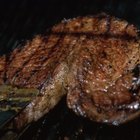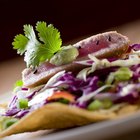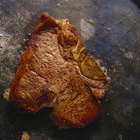gkrphoto/iStock/GettyImages
Tuna steaks are a staple in restaurants, where they're usually seared quickly over the intense heat of a gas-fired commercial grill. Few homes are equipped with one of those, and backyard grills aren't always convenient or even powerful enough. For tuna enthusiasts, stovetop cooking is often the best way to prepare tuna steaks at home.
Tuna Basics
Tuna is usually cooked at high temperatures to quickly sear and char the outside and create the powerfully savory flavors that come from browning. The lean interior of the steak remains rare to medium-rare, warming the flesh enough to be palatable without overcooking and drying it out. Marinate the steaks ahead of time, if you wish, or rub them with your favorite spice mixture -- but ensure that they are perfectly dry when you begin the cooking process. Any surface moisture will cause them to steam rather than sear.
Pan-Seared Steaks
The simplest method for cooking tuna steaks on the stovetop is by pan-searing. Pat the steaks dry with clean paper towels, then lightly brush or spray the surface with oil. Heat the skillet over medium-high heat until it's very hot, then add a half-tablespoon of clarified butter or a high-temperature oil, such as grapeseed oil or canola oil. Place one or two steaks at a time in the skillet, taking care not to crowd them. Sear the steaks for 2 to 2 1/2 minutes, shaking the pan periodically to keep them from sticking. Turn the steaks and sear them for another 60 to 90 seconds on the other side, until well-browned.
Pan-Grilled Steaks
For a more restaurant-like appearance, you can substitute a grill pan for the skillet. Grill pans are made from heavy cast metal, like skillets, but have rows of parallel ridges that simulate the marks of a grill and keep the steaks raised above any fat and drippings. Grill pans don't apply as much direct heat to the tuna, so your steaks will take slightly longer to cook. Heat the pan until holding your hand over it becomes uncomfortable, then lay the oiled tuna steaks on it at a diagonal. After two minutes, rotate the steaks about 60 degrees to make restaurant-style crosshatch markings. Cook the steaks on the first side for another minute, then flip them and cook on the second side for two to three minutes.
The Niceties
Tuna is usually served rare to medium-rare, so it's important to ensure that it at least gets warm in the middle. Taking the steaks out of your refrigerator 30 to 45 minutes before cooking helps tremendously, and is perfectly food safe as long as the tuna's been kept cold up to that point. To add flavor without steaming the tuna as it cooks, brush a flavorful sauce or marinade onto the cooked side of the steak after it's been flipped. For a different flavor and texture, coat your steaks in sesame seeds. They'll brown and become crisp in the pan's heat, lending the steaks a nutty flavor that complements most Asian seasonings and sauces.
Related Articles

How to Pan Cook Shark

Grilling Instructions for Rib-Eye Steak

How to Cook a Breaded Thick Cube Steak

Ways to Cook T-Bones Indoors

How to Grill a Mahi Mahi Fillet

Cooking Frozen Swai Fillets

How to Make Oven-Broiled Marinated ...

How to Cook Ahi Belly

How to Cook Churrasco Steak in a Pan

How to Cook Beef Tenderloin on a ...

How to Sear Two Inch Thick Wild Ahi Tuna

How to Cook Steak on a Baking Sheet

How to Cook Walleye by Broiling

Easy Ways to Cook Pork Steak

How to Cook Tuna Steaks on the Grill

How Do I Cook a Tuna Steak Without ...

How to Score a Steak

How to Grill Tuna Steak

How to Grill a Ribeye on a Weber Q

How to Smoke Tuna
References
- On Cooking: A Textbook of Culinary Fundamentals; Sarah Labensky et al.
Resources
Writer Bio
Fred Decker is a trained chef and prolific freelance writer. In previous careers, he sold insurance and mutual funds, and was a longtime retailer. He was educated at Memorial University of Newfoundland and the Northern Alberta Institute of Technology. His articles have appeared on numerous home and garden sites including GoneOutdoors, TheNest and eHow.